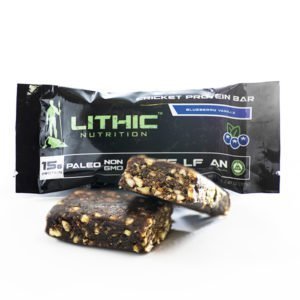After the interview to ProPro, first introducer of cricket-based energy bars in Thailand, this time we asked some questions to a North American producer. Most of the people may have heard of Chapul and Exo, but recently Lithic Nutrition is also becoming a protagonist to the edible insect market.
The Co-founders, Lars and Dave Baugh are enthusiastic about an active lifestyle and adventure. The passion of revolutionizing the supplement industry in providing nutritious and sustainable products has driven the brothers to develop cricket-based paleo bars and powders.
During his active-duty as an U.S. Marine, Dave was deployed in Southeast Asia where he first got to taste crickets and found that insects were not only nourishing but also delicious. Lars did not need much convincing from his twin brother to see the future prospective of edible insects for the American market. In deciding to commit to the plan full-time, the brothers developed a series of cricket-based paleo bars packed with an insect content percentage higher than the average cricket energy bar on the market. Thus, Lithic Nutrition was born.
Did you decide to go for an energy bar because you think it is the way to educate people to eating insects before making a mainstream CPG food?
In American food trends, the ready-to-eat snack bar has seen great growth and traction over the last several years. This is a familiar and accepted food format that has many different variations of ingredients that cater to different people. Integrating in cricket flour into a bar was a logical choice because people can identify with the product, and it eliminates the visual barrier of “eating bugs” to the consumer.
Is your cricket energy bar different from the others?
Lithic Nutrition bars boast 15g of protein, and are roughly 20% cricket by volume; more than any cricket bar in North America. We don’t dilute the protein source in our bars with other protein powders, and really try to embrace what crickets bring to the nutrition and taste profile instead of using it more as a marketing gimmick.
How do you bring on the R&D? Does it involves tests with consumers? If yes, what are the take aways?
Our R&D begins with the customers and understanding the problems and needs that exist. Lithic Nutrition’s focus has been on how to best integrate cricket to solve existing needs in different food categories that have a demand for a more natural, sustainable, and nutritious protein. We fortify the R&D team with subject matter experts that fill gaps in our team, and that can best help solve the developmental challenges that come with creating a first-to-market product.
If you imagine new products made with cricket flour, what could they be?
I really see cricket flour as more of an integrative protein rather than something that spurs new development of products. For instance, I like to think about any product on the market that uses whey or soy, and then imagine replacing that with cricket – it leaves you with an incredible amount of opportunities to integrate cricket into normal, already accepted food products.
Do you think there are other farmed insects that may be used to make packaged food? And why the vast majority of the bug startups think the crickets have a higher consumer acceptance?I think many of the other farmed insects have their place for packaged food – the challenge, particularly in American society, is that putting a word like “mealworm” on packaging can be a hurdle for many customers. Once we have a way (as an industry) to name and market an insect protein source as something more approachable, I think the acceptance level will rise. Crickets seem to be most approachable as they are a rather non-intimidating insect, and people can identify with them. On the supply side, I think most bug startups lean toward crickets because the supply and infrastructure are robust enough to support scaling a business when compared to other insects.


